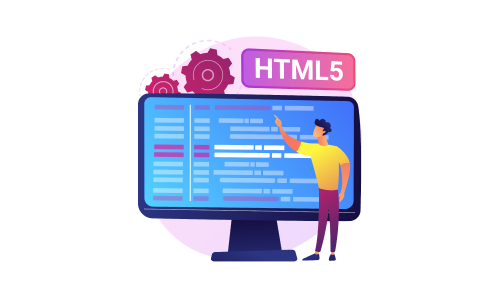Convert Flash-Based Websites to HTML5
Feb 21, 2022 14550 seen

HTML5 is the most recent version of the Hypertext Markup Language, which is used to describe web pages. There are three types of code: HTML, which provides structure, Cascading Style Sheets (CSS), which handles presentation, and JavaScript, which makes things happen.
HTML5 was created to provide almost everything you'd want to do online without the need for additional software such as browser plugins. It can do everything from animation to apps, music to movies, and it can also be used to create extremely complex browser-based applications.
There's more to it. Because HTML5 is not proprietary, you do not have to pay royalties to use it. It's also cross-platform, which means it doesn't matter if you're using a tablet or a smartphone, a netbook, or a notebook. as long as your browser supports HTML5, it should work perfectly. It's always a little more complicated than that. All of the major browsers, including Internet Explorer, Edge, Firefox, Chrome, Safari, and Opera, as well as Mobile Safari and Android's browser, support HTML5, but not all of them, support the same features.
Why Convert to HTML5?

HTML5 has completely transformed the way HTML content is presented due to its numerous advanced features such as support for audio, video, SVG, Canvas, and a variety of other file types. HTML5 is also one of the best Flash Player alternatives because it is natively capable of performing well in a variety of low-battery-powered devices such as smartphones and tablets.
Among the other benefits of HTML5 are:
- Compatibility with all modern browsers on all devices.
-
Responsive Web Design Support (RWD)
-
Works without the use of a browser plug-in
-
It includes built-in support for rich media elements
-
HTML5 output content takes up less memory.
-
Similar to Flash, it renders graphic content.
Steps to Convert Flash Websites to HTML5

1. Make a thorough plan
The transition from Flash to HTML5 is a time-consuming process that can take a long time depending on how much content you have to convert.
As a result, it's a good idea to create a detailed plan before getting started on the actual work. This will eliminate all of the hassle and stress of discovering additional items that are coming up, and you will be able to proceed with the process without any hiccups.
2. Gather the source files
Before you start converting Flash to HTML5, make sure you have all of the source files (XML, FLAs, etc.) and all of the media.
3. Retrieve media and content
Copy the text and labels of navigation buttons in the GUI (graphical user interface) into a PPT or MS-Word document after extracting all of the media and content from the existing website.
4. Use a strong authoring tool and adhere to the conversion process.
You can convert Flash to HTML5 using a variety of tools, including Adobe Captivate, Lectora Inspire, Adobe Wallaby, Google Swiffy, Sothink – Flash to HTML5 conversion tool, Apache FlexJS, and Articulate Storyline. Here are some of the most popular tools for converting Flash websites to HTML5 right now.
Google Sites Web Designer
It is a free web editor for converting Flash to HTML5. You can use this tool by simply paying an intrinsic cost in terms of conversion quality, rather than paying Adobe's subscription fee.
Adobe Animate CC
Adobe Acrobat Animate CC is an excellent conversion tool for Flash to HTML5 projects that have the.fla source files. Because Adobe is the native platform of Flash, the tool converts these types of projects to HTML5 the best.
CreateJS's Zoe Tool
Zoe is a standalone tool for converting.swf animations to sprite sheets that can be used in HTML5 Canvas. It is part of a JavaScript library package and is supported by Adobe, Microsoft, and Mozilla.
5. Comply with the conversion procedure
- Here's how to convert your Flash websites to HTML5 files:
- Open Flash file in any of the Flash to HTML5 conversion tools, for example, it can be an Animate tool.
- Select Command > Convert to Other Document Formats.
- The following step is to select HTML Canvas and then click OK.
- Change the Actions script by selecting Code Snippets.
- Selecting Convert to Bitmap and convert vectors to bitmaps.
Check that all bitmaps are exported as Spritesheets. Convert text to outlines before clicking OK to Publish.
6. Test the website content Output the content in HTML5 and test it across the various web and mobile browsers.
The Benefits of Flash to HTML5 Conversion
- The following are some of the primary advantages of converting Flash to HTML5. –
- A new look and feel
- Compatibility of devices
- HTML5 content is compatible with a wide range of mobile device browsers and desktop computers.
- Content can be easily updated.
- HTML5 websites' content, including videos, audios, animations, and so on, can be easily updated.
Conclusion
Converting Flash-based websites to HTML5 has become an unavoidable requirement for businesses all over the world, as Flash is rapidly becoming obsolete. Converting your Flash-based website to HTML5 provides numerous benefits, including increased speed, security, accessibility, and numerous other opportunities for innovation. While most business owners may perceive Flash to HTML5 conversion to be a complicated process, following the steps outlined above will guide you through a smooth and successful transition.


